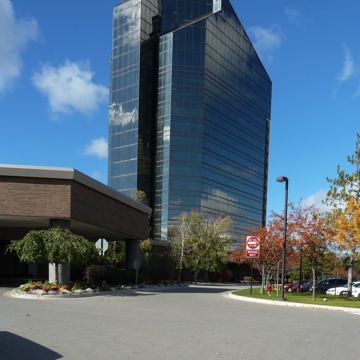You are here
Grand Traverse Resort Village (Grand Traverse Resort and Spa)
The Grand Traverse Resort Village is a “total destination” mega-resort and conference center that runs all day, all night, all year. On 850 acres of rolling orchard land atop a 180-foot-high bluff overlooking the east arm of Grand Traverse Bay, its tinted-glass-skinned steel-framed tower conspicuously intrudes on the landscape. Paul and Sue Nine of Bloomfield Hills acquired a 179-acre parcel of land with a golf course here in 1973 with the intent of developing a resort equivalent to Hilton Head on the South Carolina coast and Greenbrier in West Virginia. Within five years they increased their land holdings to 439 acres and built a golf course. In 1978–1980, they built a 245-room hotel, convention center, and indoor sports complex to the designs of Louis Redstone with Greyheck, Bell and Kline of Traverse City.
In 1982–1984 additional investors funded construction of a Jack Nicklaus–designed eighteen-hole golf course. An outdoor pavilion with a yellow tentlike roof manufactured by Owens-Corning Fiberglass Corporation covers a landscaped patio for parties and concerts year-round. Condominiums and “condovillas” created by Community Design are clustered along fairways. The huge hipped-roof Clubhouse (1999, James Nordlie of Archiventure Group) serves all three golf courses—The Bear (1985, Jack Nicklaus), The Wolverine (1999, Gary Player), and Spruce Run (1979, William Newcomb). On the grounds are tennis courts, a swimming pool, and jogging and ski trails. The architecture is ordinary; the setting is sublime.
In 2003 the Grand Traverse Band of Ottawa and Chippewa Indians purchased the resort and renovated the Tower rooms and the Grand Lobby.
Writing Credits
If SAH Archipedia has been useful to you, please consider supporting it.
SAH Archipedia tells the story of the United States through its buildings, landscapes, and cities. This freely available resource empowers the public with authoritative knowledge that deepens their understanding and appreciation of the built environment. But the Society of Architectural Historians, which created SAH Archipedia with University of Virginia Press, needs your support to maintain the high-caliber research, writing, photography, cartography, editing, design, and programming that make SAH Archipedia a trusted online resource available to all who value the history of place, heritage tourism, and learning.















